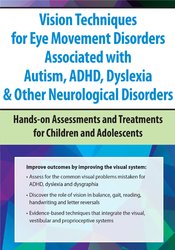

Do you work with children with ADHD, dysgraphia, dyslexia, letter reversals and reading problems that do not respond to typical treatments? Are you frustrated by a lack of progress in children who exhibit poor:
Do you know a child that cannot catch a ball and frequently trips? What about the child with autism that studies small objects in the peripheral? Or a low tone child that struggles with handwriting? These problems may be related to an eye movement or near vision focusing difficulties.
Watch this recording and learn to find the root of these problems by learning to assess eye movements and near vision. You will learn evidence-based techniques to improve vision that integrate the visual, vestibular and proprioceptive systems using interventions developed by an occupational therapist that will get results.
Thorough video demonstrations and case studies you will learn treatment techniques, including: DIY and high-tech solutions, the Brock String and Hart Chart, prism and lenses, holistic techniques, tools for balance, gait and posture and more!
These interventions can be used immediately and effectively in your practice to improve outcomes in your young patients. Master these treatment techniques and increase your confidence in your own practice abilities!
| File type | File name | Number of pages | |
|---|---|---|---|
| Manual - Vision Techniques (12.64 MB) | 102 Pages | Available after Purchase | |
| Manual - Vision Techniques - French (12.64 MB) | 102 Pages | Available after Purchase | |
| Manual - Vision Techniques - Italian (12.64 MB) | 102 Pages | Available after Purchase |

Robert Constantine, OTR/L, is an occupational therapist with over 25 years of experience in the fields of visual and neurological rehabilitation. Mr. Constantine is employed by the Pearl Nelson Child Development Center, where he focuses on the treatment of eye movement disorders in neurotypical and special needs children as well as adult stroke, TBI and concussion survivors. Mr. Constantine’s passion leads him to intensive studying of the visual system and continuous searches for new, evidence-based interventions to improve patient outcomes.
Robert has had training from the Neuro-Optometric Rehabilitation Association, a unique interdisciplinary organization that brings together the tools of optometry, occupational and physical therapy to improve outcomes for patients with neurological diagnoses. He was previously the only occupational therapist to be a member of the High Performance Vision Associates, an elite group of sports vision optometrists. As Such, Mr. Constantine has participated in sports vision screenings at IMG Academy, Hendricks Motorsports, and on the LPGA tour. He has also developed and marketed drag-racing specific glasses that have been successful in NHRA Sportsman drag racing, as well as having worked with elite NHRA racers, golfers, and sporting clays champions.
Speaker Disclosures:
Financial: Robert Constantine has employment relationships with CIAO Seminars and Pearl Nelson Child Development Center. He receives a speaking honorarium and recording royalties from PESI, Inc. He has no relevant financial relationships with ineligible organizations.
Non-financial: Robert Constantine has no relevant non-financial relationships.
The Pediatric Eye Exam
Anatomy of the Visual System
Congenital Visual Problems
Common Eye Movement Problems Affecting PT and OT Outcomes
Assessment of Eye Movements and Near Vision
Treatment Techniques for the Visual System
Vision Tools for Balance, Gait and Posture
Vision Problems Associated with:
Mid-Level Visual Processes
Coding and Goals for Eye Movement Problems
Please wait ...